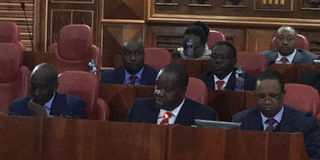Why Senate is a critical cog in the engine of our democracy

Interior CS Matiang'i (centre) with his PS Karanja Kibicho (right) and CAS Patrick ole Ntutu (left) before the Senate committee investigating the Solai dam tragedy that claimed 48 lives. PHOTO | FILE | NATION MEDIA GROUP
What you need to know:
Senates are widely held as checks against the potentially excessive powers of a popularly elected Lower House.
The architects of Kenya’s Senate were inspired by the United States Senate, itself conceived by America’s Founding Fathers as a check on the Congress.
Kenya is a classic case of countries where the senate has been caught in the crossfire of intra-elite tussles for supremacy.
Recently, Kenya has experienced a resurgence of a vicious supremacy battle between the National Assembly and the Senate.
Senates are widely held as checks against the potentially excessive powers of a popularly elected Lower House. As such, it is a salient feature of the recent global surge of democratisation, what political scientist Samuel Huntington described as the “Third Wave”.
Over the last 50 years, however, the fortunes of Senates everywhere have wilted. Out of 195 countries in the world today only 59 have national senates.
Only 15 out of Africa’s 55 states have national senates. Nevertheless, the idea of a senate has undergone seismic changes from its ancient Roman prototype.
Today, it combines Plato’s idea of the “philosopher king” and the modern concept of “a marketplace of ideas”. It is the chamber of “sober second thought” where advisory or decision-making powers are reserved for the senior — and assumedly, the wisest.
DEMOCRATIC PRINCIPLES
The architects of Kenya’s Senate were inspired by the United States Senate, itself conceived by America’s Founding Fathers as a check on the Congress.
Notably, the Senate in Kenya’s post-2010 constitutional order is hoisted on two democratic principles: (1) That leaders should govern with the consent of the governed; and, (2) That checks and balances are needed to guard against concentration of power in one institution, giving rise to tyranny or absolutism.
Had Kenya walked the straight and narrow in adhering to the American model, the supremacy wars would not be there.
The law would be patently clear on a senate sharing with the National Assembly responsibility for all lawmaking within Kenya.
For an act of the National Assembly to be valid, both houses must approve an identical document. The Kenyan Senate would have powers to ratify treaties.
LOWER HOUSE
Senate, not the Lower House, would be responsible for vetting important public appointments such as those of cabinet members, ambassadors, and judges of the Supreme Court.
And Senate would adjudicate impeachment proceedings initiated in the National Assembly.
However, Kenya is a classic case of countries where the senate has been caught in the crossfire of intra-elite tussles for supremacy over the last half a century.
Although Kenya's 1963 Constitution established a Senate consisting of 41 senators elected for six years, it was abolished in 1966 and its membership combined with that of the House of Representatives to form a unicameral legislature, the National Assembly. Its demise ushered in the dark age of one-party authoritarianism.
Article 98 of Kenya’s 2010 Constitution re-established the senate as the upper house of the Parliament of Kenya which came into force after the elections of March 4, 2013.
BALANCING ACT
Laudably, the Senate is a delicate balancing act between the principle of democratic elections and affirmative action based on gender, age and disability.
However, this experiment in inclusive democracy is awkwardly standing on its head, unable to check the excessive powers of the National Assembly.
Tragically, the framework through which the 2010 constitution was negotiated and passed gave inordinately high powers to the 10th parliament (2008-2013) to determine the fate of a refurbished senate.
Few expected the 10th Parliament to create a strong check against itself! Instead, it midwifed a weak, vacuous and ineffectual institution not worth the name senate.
The post-2010 senate remains the weakest link in Kenya’s new Constitution, tethered by the law to a devolved system rather than to a national and international mandate.
APPROVING BILLS
Its powers are reduced to representing the interests of the counties and their governments; participating in law-making and approving bills concerning counties and determining allocation of national revenue among counties.
The exception is its powers of impeachment over the President, Deputy President, County Governor, and Deputy Governors. Efforts by the Senate to play a greater role have been met with intense resistance.
In December 2015, President Uhuru Kenyatta assented to the National Government Constituencies Development Fund (CDF) Bill, sparking a new round of supremacy war with Senators charging that the law was signed without their input and against the directions of the High Court, which annulled the former law.
A few days earlier, the National Assembly’s Budget and Appropriations Committee threw out five Bills sent to it by the Senate for concurrence. Senators accused MPs of frustrating the Senate with the intention of killing it, and threatened to take legal action.
RENEWED SUPREMACY
In July 2018, a renewed supremacy battle has resurfaced with the National Assembly accusing Senators of conducting parallel investigations on the Ruaraka land saga, Solai dam tragedy, Kenya Airways probe and several others.
Legislators are wary that the two committees might present two reports with entirely different recommendations.
Abolishing the Senate is not an option. The solution lies in boldly re-engineering the Constitution to hew a strong Senate as a pillar of democracy.
Prof Kagwanja is a former Government Adviser and Chief Executive of the Africa Policy Institute. Email [email protected]





